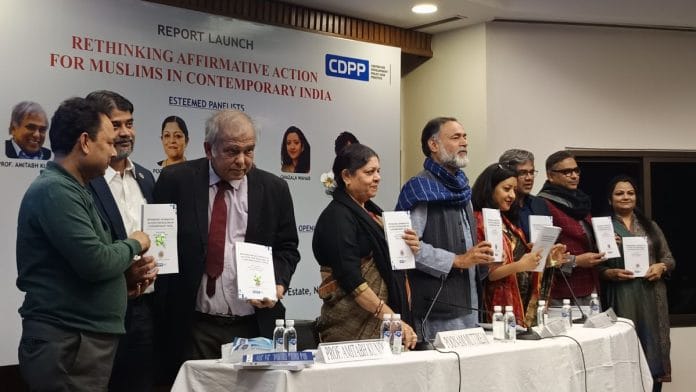New Delhi: In a dimly lit, packed hall, a video played on the screen. A young man talked to the audience, drawing an analogy—if an Olympian and a rookie compete from the same starting point, the result of the race is obvious. For a level playing field, the beginner must start ahead. It is the only way to achieve real equality.
The video sparked a discussion in the room on the country’s second-largest religious group and the Modi government’s vision of Sabka Saath, Sabka Vikas.
“There is a need to have a secular criterion to determine the relative marginalisation of Muslim communities to accommodate them in the existing framework of affirmative action,” said Associate Research Fellow, Policy Perspective Foundation, Nazima Parveen at the release of a report titled Affirmative Action for Muslims in Contemporary India.
Released by The Centre for Development Policy and Practice (CDPP), it studies welfarism in post-2014 India. Authored by Hilal Ahmed, assistant professor, Centre for the Study of Developing Societies, Mohd. Sanjeer Alam, associate professor, Centre for the Study of Developing Societies and Parveen, the report critically analyses social inclusion and the marginalisation of Muslim communities.
The launch event at India International Centre was followed by a panel discussion that featured JNU professor Amitabh Kundu, Swaraj Abhiyan founding member Yogendra Yadav, author and senior journalist Ghazala Wahab, and Population Foundation of India’s executive director Poonam Muttreja.
Armed with data from the report, Kundu compared Muslims with Hindus, SCs, STs, and OBCs across education and employment. The professor, who chaired a 2013 committee assessing the implementation of Sachar Committee recommendations stressed the need to focus on discrimination, account for qualifications, factor in experience, and then measure the actual disparity—one he finds deeply alarming.
“Equity and inequality are different, but there is something called discrimination, and we have tried to capture that in the report,” said Kundu.
He defined discrimination and explained how it manifests in various forms, such as unequal employment opportunities or wage disparities. However, these differences can often be attributed to variations in education or experience. To identify true discrimination, one must compare individuals with the same level of education and experience, and then measure the differences in earnings or property. He argued that these disparities are clear indicators of discrimination.
Also read: Islam’s Syedwad more toxic than Hinduism’s Manuwad. Denying SC quota to Pasmandas is unjust
Muslim and myths
Kundu changed the slides on the projector, showing more numbers. With caution, he directed everyone’s attention to a table. On it was the difference in never enrolled (female-male). For Hindus, 5.83 per cent, Muslims, 4.97 per cent, and Christians, 0.85 per cent. For currently attending (male-female), the difference is: Hindu – 4.99 per cent, Muslim – 5.32 per cent, and Christian – 1.29 per cent. He used these numbers to counter the myth that Muslims don’t allow women to get an education.
“Muslim level of enrollment and education is low for both men and women but the gap isn’t very high. The gap between men and women isn’t as high as other groups,” Kundu added. “There you don’t find gender inequality is sharpened among the Muslim if you compare with the different communities.”
The panellists present at the launch expressed concern about how the media shapes stereotypical narratives against Muslims. They addressed and countered these stereotypes one by one.
Poonam Muttreja tried to address the myth surrounding the increasing Muslim population.
“Muslim population, at best, will rise to 18 per cent in the next century. In fact, the Muslim population is declining at the fastest rate,” Muttreja claimed.
According to her, the media has played a disruptive and destructive role by constantly reiterating this narrative, particularly on Hindi channels. These channels contribute to perpetuating both the myth and the discrimination, fueling misconceptions among their audiences.
Also read: Look at ‘Muslim quota’ from the lens of Pasmandas. Modi-BJP have been wooing them for long
Don’t overlook lived experiences
Nazima Parveen pointed out that the report suggests addressing developmental deficits among Muslims and other disadvantaged groups in backward regions through a convergence approach, particularly with the aspirational district programme. It proposes a proactive policy to focus on occupations where Muslims are disproportionately represented, including modernizing small-scale enterprises. This policy, the report said, should provide capital, upskill workers through training, and establish mechanisms to eliminate exploitation by traders. Such efforts could improve the lives of many Muslims and create positive ripple effects.
Statistics often overlook the lived experiences of Muslims, Ghazala Wahab pointed out. According to her, even with jobs or education, stepping outside remains risky for the community. Beyond cattle traders, small business owners also face threats.
“The lived experience of a Muslim doesn’t depend on statistics, it doesn’t depend upon what the government is doing. Because the government has made the street so unsafe,” she claimed.
(Edited by Theres Sudeep)






